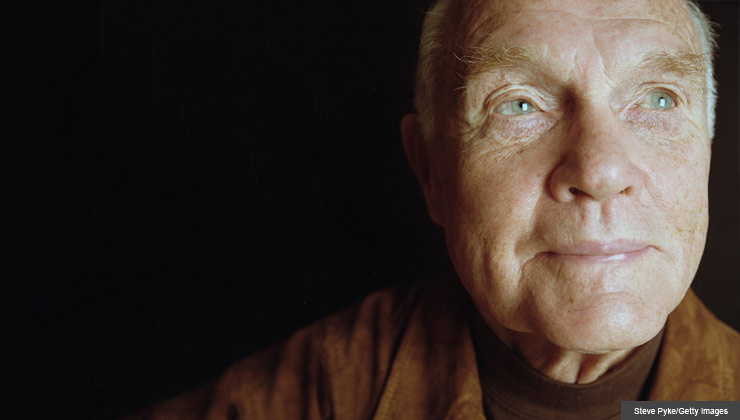50 Years After Orbiting Earth, Is John Glenn Flying High?
At 90, he’s selling his plane but still has the right stuff

Photo by Steve Pyke/Getty Images
Astronaut John Glenn is also a former member of the United States Senate.
It’s a year of milestones for John Glenn, the first American to orbit the Earth and the oldest person to fly in space.
Feb. 20 marks the 50th anniversary of his 1962 orbital flight. His career as a military pilot began 70 years ago on March 28. And now the former U.S. senator has decided that it’s time to sell his airplane, a twin-prop Beach Baron that he acquired in 1981 and has been using mostly to commute between Columbus, Ohio, and Washington, D.C.
Aviation history
Glenn got his first pilot's license in June 1941, when he was a student at Muskingum College in New Concord, Ohio. Six months later, on his way to an organ recital by Annie Castor — his childhood playmate, teenage sweetheart and future wife — he learned of the Japanese attack on Pearl Harbor from his car radio. He dropped out of school and enlisted as a Navy aviation cadet. A year later he was reassigned to the U.S. Marine Corps.
His 59 combat missions in World War II and 90 combat missions in the Korean War earned numerous military decorations for Glenn. (In the latter conflict he earned the nickname "Magnet Ass" for his seeming propensity to attract enemy flak.) As a Marine test pilot in 1957, he made America’s first cross-country supersonic flight.
When the United States entered the space race, Glenn was chosen to be one of the nation’s seven original Mercury astronauts. His first mission to outer space — and the first U.S. manned orbit of the Earth — captured the world’s attention in 1962.
“I can’t believe it’s that long ago,” he says. “It remains so vivid to me. I still can remember some of the sensations, what things felt like, some of the difficulties we had.”
He describes the whining sounds of liquid oxygen flowing into the rocket’s fuel tanks; the feeling of the Mercury spacecraft swaying in the wind; the crush of liftoff pressing his body with six times normal gravity; and finally the weightlessness of drifting in space.
The difficulties included an automatic control system that malfunctioned and forced Glenn to manually control his Friendship 7 capsule for the last two of its three orbits around the earth. And a ground instrument indicated that the heat shield on the spacecraft was loose, meaning Glenn could be incinerated during reentry through the atmosphere. But the heat shield held, and Glenn emerged from the capsule a national hero.
In 1998 Glenn returned to space at age 77 for a nine-day flight aboard the space shuttle Discovery. Critics dismissed the flight as a NASA publicity stunt, but the space agency claimed a scientific purpose: studying the effects of space flight on the elderly. Glenn has a longstanding interest in the contributions older people make to society and their families. (Both Glenn and his wife are former board members of the International Longevity Center, a not-for-profit research and policy group that addresses aging in constructive ways.)
Because aging and space flight cause similar body damage — muscle and bone-density deterioration, for instance — scientists hope to discover common treatments. By most measures, Glenn’s body held up better than the bodies of the younger astronauts on the flight, challenging the assumption that the elderly become frail.
Launch Into Politics
In the afterglow of Glenn’s inaugural orbital mission, John and Robert Kennedy urged the space hero to parlay his public stature into a political career. After an aborted candidacy for a U.S. Senate seat from Ohio and a stint as a top executive of Royal Crown Cola Co., Glenn joined Bobby Kennedy’s insurgent campaign for the 1968 Democratic presidential nomination.
He was there when Kennedy was shot in Los Angeles and, with his wife, accompanied six of Kennedy’s 10 children on a flight back to their home outside Washington, D.C. The next day, the Glenns had the sad task of telling the children that their father had died.
Glenn won a Senate seat in 1974, chaired the Governmental Affairs Committee and served years on the Senate Special Committee on Aging. Since leaving Congress in 1999, he’s focused on encouraging young people to participate in public life.
He holds an adjunct faculty appointment at Ohio State University’s John Glenn School of Public Affairs. When in Washington, D.C., where the Glenns maintain a second home, he likes to meet with students in the school’s internship program, as well as keep in touch with NASA and his former colleagues on Capitol Hill.
When invited to speak about space or aviation, Glenn says, “I usually work in something about the importance of having interest in government and politics, because that’s what determines what we do. [Space and aviation advances] don’t just fall off into the street. They come about because there are policies that encourage development in those areas.”
Also of interest: Out of this world photo gallery.
Tom Price, a Washington-based freelance writer, covered Glenn as an Ohio newspaper reporter and a correspondent in the Cox Newspapers Washington Bureau.
Also of Interest
- A Boomer’s History of Mars
- Which states tax Social Security benefits?
- Help bring relief to struggling seniors; find volunteer opportunities near you
Join AARP Now — Receive access to exclusive info, benefits and discounts
